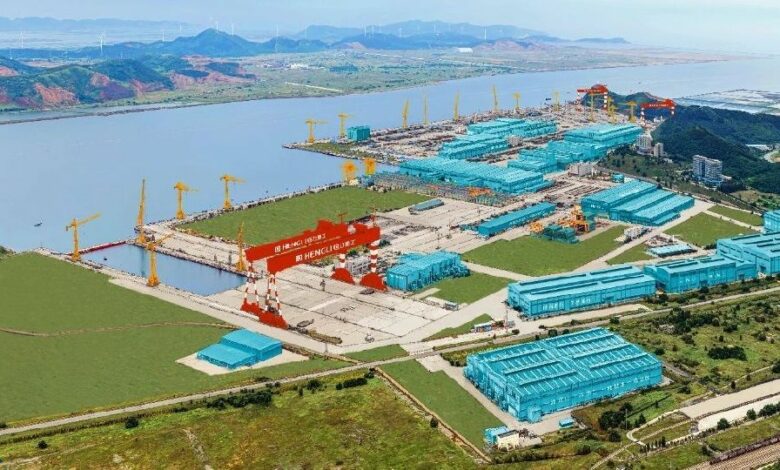search the site
Number of active shipyards jumps by 17.7% in two years

Sam Chambers
Shipyards are making the most of the current newbuilding boom with new data suggesting the number of active yards has leapt by 17.7% in the space of the last two years.
In June 2022, there were 153 active shipyards, according to Greece’s Xclusiv Shipbrokers. This number climbed to 180 this month, with China accounting for most of the growth. Yard activation comes at a time when shipbuilders are basking in very long order books, with prices at highs not recorded for close to a generation. Splash has reported recently on container delivery slots being marketed for 2029 and LNG slots being negotiated for as far out as 2030.
As of early June 2024, the orderbook-to-fleet ratio according to Xclusiv for bulk carriers, tankers, containers, and gas carriers stood at 9.3%, 10%, 20.3%, and 47.7%, respectively. This represents a significant increase compared to the previous year. The orderbook-to-fleet ratio for bulk carriers, tankers, and gas carriers has grown by 43%, 72%, and 48% respectively over the past two years.
Containership ordering, which faded in the second half of last year in line with falling rates, has roared back in 2024 with the onset of the Red Sea shipping crisis. In the year to date, 64 container ships have been ordered for a total capacity of 543,500 teu according to the latest data from Alphaliner.
Shipyards’ global orderbook currently stands at more than 133m compensated gross tonnes (cgt), an increase of 56m cgt compared to the orderbook’s most recent low in late 2020, according to shipping organisation BIMCO. LNG and containerships have accounted for respectively 35% and 30% of the increase.
The number of LNG newbuilding orders has more than doubled from the same period last year where 34 orders were placed, compared to 78 in the first five months of 2024, an increase of 129%, according to recent analysis from VesselsValue.
After a decade of declining output, shipyard production has begun to edge up in recent years with deliveries in Q1 reaching a seven-year quarterly high of 10.1m cgt, according to data from Clarksons Research. Clarksons is projecting a 15% increase in shipyard output for full year 2024 to 40.6m cgt.
Analysts at Danish Ship Finance are bullish on the outlook for the shipbuilding industry, but only in the short term, with global utilisation rates forecast to peak in 2024 before potentially softening in the following two years.
“Continuously firm contracting activity and limited yard availability are pushing newbuilding prices ever closer to an all-time high,” Danish Ship Finance noted in a report issued last month.
Splash has been reporting a great deal about new shipyard capacity hitting the market.
For instance, Jiangsu-based New Times Shipbuilding, one of China’s largest privately owned shipyards, is awaiting government approval for a new drydock with broker Gibson reporting Q1 2027 deliveries will open up once the yard gets the green light.
After several years of capacity reduction, last year saw several attempts to reopen some Chinese facilities.
Hengli Heavy Industries Group, a subsidiary of the Hengli Group, is running the assets of STX Dalian. The yard restarted in January 2023.
In August 2023, Wuhu Shipyard took over the land and facilities of the former Samjin Shipbuilding Industry part of the automobile group Chery.
Kouan Shipyard has been going through a reorganisation process since 2019 and is currently building blocks and ships for the account of third-party shipbuilders including Dajin, Taizhou Changqin and Taizhou Changyue.
Jiangxi New Jiangzhou Shipbuilding lndustry was established on March 31, 2023. The main investors are Qinshi (Xiamen) Trading and Jiangsu Yangchuan Investment Development. Qinshi (Xiamen) is the parent company of a listed company, Bestway Marine & Energy Technology, whereas Jiangsu Yangchuan is a subsidiary of Yangzijiang Shipbuilding Group. The yard has signed contracts for stainless steel tankers with Chinese buyers.
Private company Fujian Guanhai Shipbuilding, which stopped production in 2013 and went bankrupt in 2019, has now been taken over by Fujian’s private steel giant Jinshenglan Group and renamed the Fujian Songmin Group.
Quanzhou Shipyard, which was established in 2004 and entered bankruptcy in 2019, reached an agreement with a local government-owned company to invest and reorganise the yard. In September 2023, a ceremony was held for the resumption of work and production.
The Review of Maritime Transport 2023, published in September by the United Nations Conference on Trade and Development (UNCTAD), urged shipyards to expand quickly to aid with shipping’s green transition.
“Shipyard capacity is currently facing constraints. Tanker and dry bulk owners are anticipating long waiting times and high building prices. Increasing shipbuilding capacity is crucial to ensure that shipping meets global demand and its sustainability goals,” the UNCTAD report stated.
While many other analysts are predicting bottlenecks at shipyards, with shipbuilding executives mulling expansion plans for the first time since the global financial crisis, the Danish Ship Finance report takes a contrarian view, based on how it sees seaborne trade volumes declining in the coming decades. Demand for shipyard capacity may decline by 25% towards 2040, the Danish report predicted.
During the previous shipbuilding boom in the first decade of the 21st century, one severe constraint was the availability of main engines, a trend that is beginning to reemerge and will be something reported in depth by Splash next week.
source : Splash


















